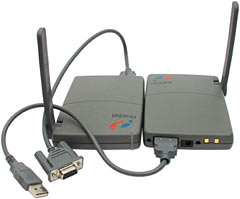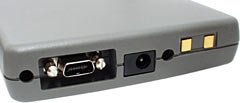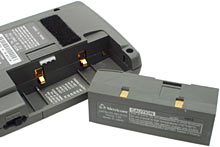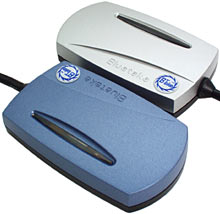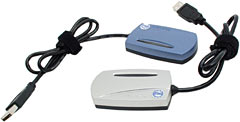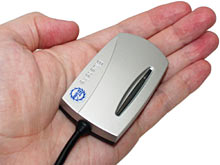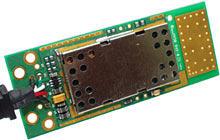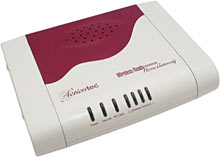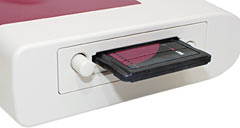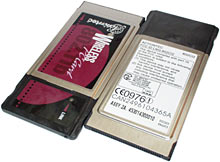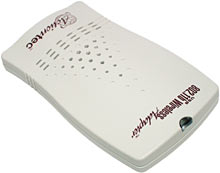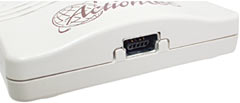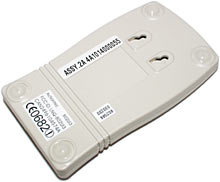
Wireless networking roundup: Ricochet, Bluetooth and IEEE 802.11b
Review date: 2 February 2002. Last modified 29-Aug-2012.
Wireless PC networking is following the same path that wired networking did.
It started out very expensive and obscure. Small office and home users couldn't come within a mile of affording it. But that was OK, because they would have needed two years of training to make a Wireless Local Area Network (WLAN) work anyway.
Then the first few relatively cheap consumer WLAN products showed up, but they weren't very good. Gear like the original Diamond Homefree WLAN cards, for instance, only had one or two megabit per second bandwidth (and rather less usable bandwidth), and commonly turned out only to work properly in situations where you could have easily run a darn cable anyway.
Now, though, wireless is going mainstream. Ask an Apple user how easy their flavour of IEEE 802.11b WLAN is to set up; PC solutions aren't much harder.
Or shouldn't be, anyway.
Talk about WLANs these days and people are likely to assume you're talking about 802.11b, also known as "Wi-Fi". It's easily the most popular system, with decently priced hardware and 11 megabit per second maximum bandwidth.
There are other ways to connect computers wirelessly, though.
So I've checked a couple of them out, along with some 802.11b gear.
First up - the dirt cheap option.
Ricochet modems
Ain't bankruptcy great?
Metricom was the company that ran the Ricochet wireless Internet access network in various cities of the USA - they farmed out ISP duties to other companies, but maintained the network themselves. Unfortunately, they suffered an unrecoverable realignment of their ongoing profitability paradigm half way through 2001.
The Ricochet network used wireless modems operating on the 900MHz band. The modems themselves have OK but un-amazing radio range, but Metricom ran poletop repeaters that gave the system quite good coverage.
Company go bye-bye, routers stop working, modems become useless.
To most people.
Here are a couple of "GS" model Ricochet modems, the last and best model. GS Ricochet modems work at 128 kilobits per second, as fast as any Ricochet modem; so do the previous "GT" modems. Everything older is slower. I picked these two up on eBay for $US100 the pair. Plus shipping, plus the price of the 240 volt AC adapters I bought to replace the 110 volt American ones the modems come with.
Cheaper 802.11b network adapters go for around $US70 to $US100 each; you can find PCI 802.11b "adapters" for about $US50, but they're just PCI-to-PCMCIA adapter boards. They let you plug a laptop 802.11b adapter into a PC, but in order to do that you still have to buy a laptop 802.11b adapter.
One of the modems in the above picture has a nine pin serial cable coming out of it; the other one's USB. You can actually use a GS modem in either mode...
...because they come with both flavours of cable, which connect to this micro-port on the back of the device. Use USB and you need a driver; use serial and you don't. USB apparently has the potential to give you speeds considerably above 128 kilobits per second, but I haven't seen it, and you shouldn't expect to get such speeds over any significant distance with the stock antennas.
The GT/GS modems also have a built-in battery which, when new, is good for something like five hours of use; your mileage will vary depending on how clapped out the battery you get happens to be. Assuming the battery's OK, these modems work perfectly with laptops, without impacting the computer's battery life.
Everything worth owning in the Ricochet portfolio's been bought by Aerie Networks, who may actually make good on their promise to reactivate the network. But you don't need to be in an area served by poletop thingies to use a Ricochet modem. In fact, it generally seems to help if you don't have routers trying to tell the modems what to do, if you just want to connect one modem to another.
Here in Australia, ten thousand miles from where any Ricochet network ever was, ought to be far enough away.
Two Ricochet modems can call each other in point-to-point (P2P) mode and act pretty much like any other modem, as far as the computer you plug them into is concerned. You just tell one modem to dial the number on the sticker on the bottom of the other modem. The number will be something like 03-1234-5678; the dashes are important. If the other modem's set to auto-answer, it'll now say "RING" to its host computer, just like an ordinary phone line modem, and the connection will proceed as normal. Except rather faster; there's no noticeable negotiation delay when Ricochet modems connect.
Ricochet modems have a "star mode" as well, which lets you use them as something more closely resembling a genuine WLAN rather than in P2P, but there's no plug-and-go way to do that. Linux enthusiasts, though, are welcome to go for it.
Ricochet modems have several limitations. P2P is a killer limitation in and of itself, of course; if you want a real WLAN, getting one happening with Ricochet modems is a lot more work than a lot of people want to do.
Then there's speed. Whether you use USB or serial, the best speed you get out of these things is likely to be no higher than 115200 bits per second, which is super-fast by phone line modem standards but miserably slow compared with any Ethernet or 802.11b LAN. Deduct the usual overhead and you get ten kilobytes of user data transferred per second; maybe a bit more, with a following wind.
Latency's not too hot, either. 70ms or so, with considerable "burstiness" caused by the packet radio transmission system these modems use (which, yes, means they're not really modems; neither are "cable modems"). Two people could play action games over a P2P Ricochet link and probably have more fun than they would over a modem connection, but the difference wouldn't be huge.
So what's good about these things?
Well, as mentioned above, they are pretty cheap. Caveat emptor applies on eBay, of course, but the two modems I got are both in near-new condition, complete with full packaging and outdated Metricom-network driver discs. Windows XP comes with a Ricochet modem driver, by the way; users of other Windows flavours may need to go on a driver hunt. You can, of course, just use the modems in serial mode. They'll work with anything that speaks RS-232, then, with no special driver required.
This is so because the Ricochet modems use normal AT commands - with some oddities, but nothing crippling. So you can make them work with all kinds of other communications software, quite easily. It's a bit of a blast from the past, and Ricochet modems just say "ERROR" whenever you get something wrong and don't give you the vaguest hint of what the error might be, but anybody who knows his AT&F from his ATA shouldn't have any big problems.
Just read one of the online guides - the whole Metricom AT command manual's on the Web here, for a start - and you'll be away.
Among the things you can do over a Ricochet link is making a Virtual Private Network (VPN). It won't be lightning fast, but it'll be faster than doing it over a dial-up modem connection, and much faster than doing it over some lousy GSM cell-phone 9600 bit per second link. Not to mention cheaper.
This doesn't mean that Windows won't stick a five foot pipe wrench in your remote networking attempt, in its usual What Workaround Do You Want To Be Forced To Use Today? fashion, but it really won't be much harder than usual.
You've got to be in range, though.
The four inch rubber-ducky antenna on the Ricochet modems is supposed to give them a one mile line-of-sight range, but 900MHz gets eaten quite quickly by pretty much everything denser than air, so in the real world Ricochet modem range isn't that great. It varies enormously with terrain and antenna position, but we're talking coin-on-your-street-directory sort of range, not coffee-ring-on-your-city-map.
You can improve this situation by grafting on another antenna. Doing this is not a five minute proposition, but it won't require surface mount rework either. The antenna wires attach inside the modem with a Sub-SubMiniature (SSMT) connector (see PDF file here). SSMT is a somewhat obscure standard, but the connectors and cables are a line item at serious electronics suppliers; it wouldn't be rocket science to graft a more standard antenna fitting onto an SSMT cable and then hook up a higher gain directional antenna, which could get you connected over quite impressive distances.
Apparently some Ricochet modems have some weird issues to do with nameserver registration (see here), but the two I got to play with don't.
A Ricochet connection's likely to be as secure as many people need, too. We're just talking security through obscurity, here; a determined attacker could no doubt sniff your Ricochet packets with no trouble. But if you're in a country where Ricochet modems were never even sold over the counter, you can be pretty confident that no punk in a Volkswagen is sitting outside your building reading your e-mail.
Compared with most 802.11b networks, mind you, a Ricochet link is like an armoured train. 802.11b can be very secure, but as it's implemented by most people, you might as well be dangling live Ethernet cables out of your office windows with "Please h4XX0r our b0XX0rz" signs attached.
More about that in a moment.
There's a little more Ricochet troubleshooting info here. There's a quite comprehensive page about Ricochet modems under Linux here.
You'll know if you want them.
Getting the blues
Bluetooth is to 802.11b as USB is to Ethernet, basically. It's a close-range standard meant to connect gadgets to each other at moderate speeds. Bluetooth isn't meant to be used for networking, any more than USB is - but, like USB, you can bludgeon Bluetooth into a WLAN-ish role if you really try.
Bluetake is a spin-off of Thermaltake, the well-known heatsink-and-fan company. Bluetake makes both 802.11b and Bluetooth gear.
These two "Bluetake USB Dongles" come in the one box, for a list price of $US189. They're simple enough devices; USB cable, little box with a window and an LED under it. That's about all you can see from the outside.
The dongles are made for portability; the cables have refastenable hook-and-loop ties, and you get a few self-adhesive hook-and-loop squares as well, to make it easy to stick the dongles to your various computing devices.
They're not big, either.
Each dongle contains a minuscule circuit board, with an even more minuscule circuit-trace antenna. 2.4GHz is nice that way. The waves are so small.
The RF shield over the middle components just pops off, revealing some flash RAM and the main controller chip.
The line-of-sight range of these "Class 1" Bluetooth devices is alleged to be 100 metres (smaller "Class 3" devices only promise ten metres), but if you're not computing on the prairie, you're unlikely to manage that. 2.4GHz is even less penetrative than 900MHz, and these are really low power devices.
They've got a relatively low bit rate as well, though - 723 kilobits per second, peak - and that helps to stretch the range out. You shouldn't have any serious problems getting Class 1 Bluetooth devices in a home or small office to see each other, even if you're also running an 802.11b network, which'll also be using 2.4GHz. It's not like getting low power infra-red data transfer to work; you don't have to put things next to each other, or aim like a sniper.
723 kilobits per second is about 88 kilobytes per second, but as usual there's a pile of overhead and so you don't get that kind of throughput for user data. Bluetooth isn't meant to be used for moving hundred megabyte files from place to place; it's meant to connect portable devices to modems and printers, and connect wireless headsets to telephone gear, and that sort of thing. For those purposes, a modest data transfer rate is acceptable.
Bluetake provide Widcomm software with their USB Dongles. It can do quite a few things. The first thing it can do is drive users of Windows XP up the wall while they install it.
Windows 2000 and XP have a great enthusiasm for cryptographically signed drivers. Users of these OSes will probably have noticed that installing most drivers prompts a complaint from Windows that the new software is not signed, sealed and delivered by Microsoft, and may cause cancer in rats.
Normally, you just click past these warnings. And that's the case when you install the Widcomm Bluetooth driver software. You just have to click rather a lot of times.
In Windows 2000, it's not so bad. You only get four repeats of the "The software you are about to install does not contain a Microsoft digital signature..." warning, plus one more when you actually plug the gadget in (as with many USB devices, you install the software, reboot, and then plug in the device).
No big deal, that; you usually get to see the warning window more than once when you install a multi-function device that looks like several objects to the OS. That's what the Bluetooth gadget does; it looks like a string of "virtual COM ports" that let the computer make wireless pseudo-serial connections to remote devices, but it also looks like a normal modem, a fax modem, a null modem, a network adapter, and a USB device.
In Windows XP, the software that came with the Bluetake dongles required me to cancel XP's unsigned driver warning ("the software you are installing ... has not passed Windows Logo Testing...") no fewer than 14 times. Huzzah.
Once you've got the software installed, computers with the dongles attached can see each other, and interact via a "Bluetooth Neighborhood" system that makes it quite easy to run and stop different Bluetooth services on your computer, and connect to services elsewhere.
You can, for instance, transfer files. This is done in the old designate-a-single-shared-directory way; it's not normal resource sharing. Copying files back and forth is perfectly straightforward, though; the Widcomm software just creates an FTP connection between the two computers for you.
The speed of the FTP transfer isn't exciting at all. It managed around 50 kilobytes per second when I tested it, which is about 410 kilobits per second of user bandwidth. On a 100BaseT Ethernet network you can expect to be able to shift a hundred megabyte file from one computer to another in less than 15 seconds; over Bluetooth, you're talking more than half an hour.
The Bluetooth virtual serial ports work like a serial connection between two nodes; for PC-to-PC connections this only seems likely to be useful if you want to wireless-ify some application that normally uses a serial link (like, for instance, various old Point Of Sale software packages...).
More handily, you can share a dial-up modem on one computer so that another computer can use it. You can do the same trick over any normal wired or wireless LAN, of course, but the Bluetooth option is straightforward enough. You can access a Bluetooth-enabled cellular phone for data calls by using this same function.
The Widcomm software lets you share other kinds of Internet connection by using Microsoft's Internet Connection Sharing on a Windows 2000 or XP host machine that's connected to the Internet. Apparently the earlier versions of ICS won't work, but you can use other sharing software to do the same thing - connecting the Bluetooth network adapter to the Internet via some other network interface on the host machine - on any OS you like. ICS is just convenient because it comes with Windows and requires close to no configuration. And, to be fair, also allows close to no configuration, whether you'd like to change its behaviour or not.
However you manage it, this sharing option doesn't connect a Bluetooth client to the LAN proper for Windows networking. It just gives the client Internet access.
There's also "Information Exchange", which allows Bluetooth-enabled devices to swap certain kinds of data. "Certain kinds of data" currently means "Microsoft Outlook business cards, calendar entries, notes and messages, which can all be automatically synchronised via a protocol supported only by Outlook".
So if you use Outlook as your personal information management software, this is a simple way to keep your laptop and desktop computers synchronised. It might even work with palmtops. If you don't use Outlook - and there are one or two reasons not to - the Information Exchange and sync functions, as they currently stand, are of no use to you.
Bluetake also allowed me to check out their new v1.2.1.8 software, which smooths out the interface and adds some significant new features. Multiple connections, for a start - the earlier software only allows one Bluetooth Internet sharing connection per host for modem or LAN sharing purposes, while the new software supports up to seven. There's a convenient new "Send To Bluetooth" option to easily transfer files to another Bluetooth device, as well, and a TCP/IP tunnel function that allows games to be played over the Bluetooth connection.
The new software required 17 cancels of the WinXP unsigned driver warning when I installed it (or maybe 18; I lost count). I found v1.2.1.8, otherwise, to be absolutely excellent in all respects, except for the fact that it showed no sign whatsoever of actually working, on either my Win2000 or WinXP test machines. Bluetake tell me that's because the dongles they sent me have old firmware; the current versions are apparently different, in a good way. Watch this space.
Overall, Bluetooth is a lousy WLAN option, for the same reason that a screwdriver is a lousy hammer. That's not what it's meant to do. Bluetooth is meant to give you easy slow-ish connections between a variety of gadgets, mostly portable ones.
Bluetooth isn't a big thing yet. That's partly because early Bluetooth devices had an unpleasant tendency to not actually work together, but it's also because the new protocol's afflicted with the same vicious-circle problems that slowed the acceptance of USB.
If you do happen to need to graft Bluetooth connectivity onto a Windows box, the Bluetake dongles will do it, and the standard software is OK.
The dongles aren't what you'd call dirt cheap, but you do get two dongles in the box, so you can kit out both your home PC and your work one to synchronise with your shiny new Nathan Barley handheld.
Bluetake have also recently come out with a cheaper single-dongle package.
What if you want an actual, honest to goodness, standard WLAN, though?
Then it's 802.11b time.
I would have said it was "Wi-Fi time", but it's my opinion that "Wi-Fi" is a dumb name.
Wireless action
Actiontec make a variety of communications and networking products, including a full range of 802.11b gear. Within the USA they sell it all direct, too, via their on-line store.
I've checked out, in increasing order of size, their PCMCIA and USB 802.11b network adapters, and their Wireless-Ready Multimedia Home Gateway.
Let's look at the big thing first.
If you want to share an Internet connection on a LAN - or a WLAN, for that matter - you need either a computer or a dedicated "network appliance" to do it. I looked at three ways of doing the job on a LAN in my article here; the best combination of simplicity and functionality, for many purposes, is a stand-alone appliance. Like this one.
Actiontec's Wireless-Ready Multimedia Home Gateway has three different fonts in its product name, but that's the worst thing about it. It costs $US104.95 direct from Actiontec. But it can cost more.
The reason why it can cost more is that it's got this pair of PCMCIA slots in one side. Install an 802.11b network adapter in the top slot, and you find out why the "Multimedia" is in this gadget's name; it can, with the extra card, share Internet access and LAN traffic on both Ethernet and 802.11b.
The top PCMCIA slot in the Gateway can accept only an 802.11b card, and preferably an Actiontec one; other cards may work, or may not. The second card slot's for other devices, none of which I have - apparently you can plug in things like Voice over IP or HPNA or HomePlug or, indeed, Bluetooth cards there. If I get hold of such devices, I'll try it.
On the back of the Gateway there's the usual suite of switch/sharer ports. DC input socket for the included AC adapter, recessed reset button for when something goes Terribly Wrong (not necessarily with the Gateway, mind you - if you forget your password and want to change the Gateway's configuration, it's time to prod that button), and five RJ-45 sockets. One of them you connect to your 10/100BaseT-equipped cable modem or DSL adapter or what have you, and the other four go to nodes on your network, or cascade to other hubs or switches. The Gateway comes with a single five foot RJ-45 cable.
Ignore the wireless option and the Gateway has a perfectly good feature set for a device of this type. It works as a 10/100BaseT switch, and its four ports are enough to handle most home networks without any other appliances. It does Network Address Translation (NAT) Internet access sharing, so you don't have to fool with client computers' proxy settings. It works as a DHCP server, so it can dole out TCP/IP setup information to computers on the LAN. It can also work as a DHCP client, though, so if you've already got a server on the LAN, the Actiontec box won't butt heads with it.
And, by default, the Gateway passes through all of the usual Internet traffic, so users on your LAN can access all of the usual Internet services, play games, and so on. Incoming requests, the Gateway will block, though; like other such appliances, it serves as a firewall.
You can also block services for particular machines, block access to particular Web sites, and turn on Remote Management so you can administer the Gateway from a machine elsewhere on the Internet. More advanced users can do port forwarding, and can also create a "DMZ" pass-through for a local server, to make it appear to be outside the Gateway's firewall.
You can even change the Gateway's MAC address, if you've got one of those persnickety ISPs that authenticate users based on the MAC address of the one network adapter they give you when they install your service. Without MAC address changing, that means you can't use anything other than a computer with that one network adapter in it to connect to your broadband box. But the Actiontec gateway can pretend to be anything.
There's also a Web activity log, so you can see where people on the LAN or WLAN have been surfing. And the Gateway's firmware is upgradeable; versions with new features and/or bug fixes can be user-installed.
Oh, and the Gateway comes with a vertical-mount stand as well, so you can reduce its footprint if you like.
You set the Gateway up with a Web interface; you plug it into your network and look at http://[its IP address], and it serves you an HTML form that lets you enter your Internet access details and set up anything else you want. This, also, is a standard sharer-appliance feature, these days; some fancier appliances also have serial and/or telnet interfaces, but most users don't want or need them.
The Web interface lets you set up a host identifier if your ISP requires it, and it supports PPPoE for DSL connections as well. So there shouldn't, as far as I can see, be any two-way broadband adapters that can connect to the Gateway but won't work with it. Users of asymmetric satellite access will have to make their own arrangements.
The Actiontec documentation covers the Gateway setup process quite well, and walks you through various network configuration tasks on the PC side too, covering 95-series and NT-series Windows flavours. There's nothing specific about Windows XP, but that's enough like Win2000 that it should only be a problem for a few users.
With an 802.11b card installed, the Gateway lets you set it up as a wireless access point - the bridge between the LAN and the WLAN. 802.11b network adapters can work without an access point, in what's known as an "ad hoc network", but they can't talk to a LAN that way. You can make your own access point by setting up a PC with both kinds of network adapter as a bridge - Windows XP makes this quite easy, as you'd blooming well want it to for the money - but doing it with an appliance is a more elegant solution.
When you set up the Gateway as an access point, still using the Web interface, you choose a Service Set ID (SSID) and a channel for your network. This is all that a lot of WLAN users do before they start using the WLAN. That's bad.
The SSID is a name that you have to enter in the WLAN setup on client machines for them to be able to connect to the network; it's kind of like the workgroup name of a Windows network, and that's about how much security it provides, too. It's trivial for anybody to sniff the SSID of a WLAN and see what channel it's running on; there are various tools that do it automatically.
Fortunately, the Gateway also supports Wired Equivalent Privacy (WEP), the encryption standard that's meant to make WLANs as secure as wired LANs, so some joker driving past with an iBook can't walk all over your network while he waits at the lights.
The Gateway supports 64 and 128 bit WEP, as do the Actiontec 802.11b adapters. 64 bit cryptographic keys are very hard to brute-force crack; you're not going to do it with a room full of computers, but you could do it in a year or two with a building full of computers. You might get lucky and strike a working key early in the cracking attempt, of course, but that's not the way to bet.
128 bit keys are ludicrously hard to brute-force crack; we're going to need some very different computing technology in order to ever do it.
128 bit WEP, however, is not nearly as secure as its hefty key size suggests.
WEP, in standard trim, uses static keys; there's no way to make it automatically, periodically change the keys, so most organisations stay with the one keyset forever. This wouldn't be a problem, if it weren't for the fact that WEP is also cryptographically flawed. Its key generation scheme is weak, and it tends to generate keys from a very small subset of the keyspace it ought to use.
This means WEP can be passively broken - an attacker can record some network traffic and analyse it at his or her leisure, without betraying his or her existence by sending anything to the WLAN under attack, and have the WEP key in disturbingly short order.
Anybody who can set up within radio range of a WEP-protected WLAN they want to compromise - and radio range can be a very long way, if they sit on a hill with a directional antenna - can gain access without much trouble, using free software. They don't have to read scientific papers and then cut their own code.
Other entertaining tools lend themselves to use in this application, as well.
WLAN administrators can try to reduce signal leakage by choosing better antennas, but consumer gear like Actiontec's doesn't let you do that, and it only reduces the problem, in any case.
"802.11i" is an update to the standard that adds an authentication layer to WEP and ought to make it more useful, and there's per-packet keying technology on the way too, and Cisco have their own solutions, and no doubt there are others out there too. But no consumer products I know of support these new features, yet. The Actiontec gear doesn't.
In the meantime, it's perfectly possible to make WLANs secure by using higher-level security and authentication systems, like IPsec and NoCatAuth, but that's not a possibility for most users, who haven't a clue where to start.
If you're not using that level of security - and a hilariously high percentage of WLANs don't even use WEP - you're inviting the world to rummage through your digital underpants drawer. Wardriving has been a reality for quite a while now.
While I'm being nosey - the Gateway's circuit board isn't particularly unusual. Well, if you don't count the unused 24 pin header in the far corner, which I don't know what it's for. The reason I looked inside the box was to make sure there wasn't a fan in there.
Few network appliances have fans, these days, but the ones that do have a tendency to drop dead not very long after the fan does, and it's surprising how quickly that can happen when you sit the appliance on the dusty floor, or stick it in a cupboard.
If you notice the fan grinding away before it dies, you're likely to find that it runs from the appliance's power bricks output voltage, which is probably something like five or six volts, so you can't swap in a standard 12 volt fan.
This is a small pet peeve of mine. Grumble. Whine.
The Actiontec Gateway is, pleasingly, fanless. And it doesn't get alarmingly hot in use, unless you bury it under a pile of unwashed clothes or something. Yes, bachelors, I'm talking to you. So I see no reason why, barring such abuse or horrible power supply problems, the Gateway shouldn't last for many years of continuous service.
Actiontec's PCMCIA (or "PC Card", but that name hasn't really taken off compared with People Can't Remember Computer Industry Acronyms) 802.11b cards. Actiontec sell them for $US104.99 each; the cards plug straight into anything with a Type II PCMCIA slot. That means laptops, generally, but you can get PCMCIA adapters for PCs as well. And then there are oddball devices like the Multimedia Home Gateway.
These cards don't have a fold-up antenna or any sort of external antenna socket; like most of these devices, the antenna is encased in plastic on the end of the card. That makes it hard to hurt, but doesn't help its range. Actiontec aren't over-optimistic about the range of the little antenna; they say 300 feet outdoors, or 100 feet indoors, and that sounds about right. Indoor range depends on the composition of your walls and various other factors, but 802.11b is not nearly as flaky as the early consumer WLAN options.
Note, however, that 802.11b will only run at its full 11 megabit per second speed when it's got a good strong signal, and that's not something it'll have if you're on the outer edge of the antenna coverage. Past about half of the maximum range, or in any other situation where the signal's weak or there's a lot of interference, 802.11b steps down its speed to 5.5, 2 or even only 1 megabit per second. Out on the fringe, alignment of the antenna can make a large difference. You'll also want to keep your big wet microwave-absorbing body out of the path between antennas.
Actiontec have a PCI 802.11b network adapter for PCs that costs the same as their PCMCIA adapters, but this is a simpler option. It's a USB 802.11b adapter, which also costs $US104.95. It installs in the same way as a USB Ethernet adapter, doesn't require you to crack the case of your computer, and can be used with any PC that's got USB ports.
USB Ethernet adapters are convenient, but they're slow. USB doesn't have enough bandwidth for 100BaseT, so you're stuck with the older 10BaseT standard. USB does have enough bandwidth to do full speed 802.11b, though, so you don't lose any throughput by picking this kind of WLAN adapter.
The USB adapter's a svelte little thing, but that means it has to use a micro USB socket for its cable connection. Not a big problem, and the adapter of course comes with a cable, but this does rule out using other plain A-to-B USB cables to connect the thing.
The underside of the USB adapter has a flat spot for affixment of the self-adhesive mounting substance of your choice, plus a couple of keyhole slots so you can also hang it from a couple of screws.
Again, this is an internal-antenna, no-socket device, so it won't be of interest to the people who scrutinise confusing FCC regulations and then find novel uses for snack and juice cans, and/or spy on people before making them weird offers. Actiontec specify the same 300 foot outdoor, 100 foot indoor range for this unit that their PCMCIA cards manage, and it's just as plausible.
The above links aren't even the start of WLAN antenna geekery, by the way.
802.11b limitations
The 11 megabits per second that full-speed 802.11b offers you is quite enough for many small networks. It'll give you about the same raw file transfer speed as 10BaseT; not what you want for a major file server, but good enough for pretty much all purposes.
But because 802.11b is a Carrier Sense Multiple Access/Collision Avoidance (CSMA/CA) network (the same as the old 10Base2 Ethernet standard that many LANs used before 10BaseT got cheap), it doesn't scale terribly well. The more nodes you have on an 802.11b WLAN, the lousier the share of the total bandwidth each node will get, when multiple nodes are trying to talk at once.
That doesn't sound too bad, but each node adds overhead. If you upgrade a five node WLAN to a 10 node one, each node on the bigger WLAN will end up getting rather less than half of the bandwidth share that each node on the smaller one had. If nobody wants to hit the WLAN hard at the same time as someone else, this isn't a problem, of course. When you've only got 10BaseT-ish bandwidth to start with, though, quite modest network activity can become painfully slow on a multi-node 802.11b WLAN. If everybody's got lousy signal and is thus running at 1MBps then the congestion problem won't be nearly as serious - but since everybody's bandwidth will stink in that situation anyway, that's not a consolation.
To deal with the congestion problem you can "segment" the network, putting groups of users on different network frequencies. It's apparently only practical to use three different channels on one WLAN; any more than that and interference issues are apparently likely to crop up.
People on different WLAN segments won't be able to see each other, but they won't be able to eat each other's bandwidth either. This can make multi-access-point networks a pain to set up, though; what you gain on the swings, you lose on the roundabouts.
Multiple 802.11b access points have to be used if you want good coverage over a large area. Getting multiple access points and multiple segments working together is annoying, though; if your users stay put then it's not such a problem, but if they aren't moving then you can plug good old fashioned wires into their computers, save rather a lot of money and avoid the whole issue.
You can put bridges in between WLAN segments, which check to see whether traffic is intended for someone on another segment and only let it through if it is. This can let you build a large WLAN with more efficient bandwidth use, but it's more advanced networking than most people want to have to deal with, and there's still the large-area-coverage problem if someone carries a Segment 1 node off to Segment 3.
Overall
If you're a serious organisation with serious secrets that you seriously don't want passing wardrivers to learn, 802.11b isn't a technology you need to avoid like the plague. But 802.11b plus WEP, as it currently stands, is not nearly secure enough for your purposes. Serious organisations ought to have serious network administrators, though, who can get a properly secure solution running. You don't need to IPsec-ify the whole corporate network, just the wireless portion.
Even if you're a home user, running a WLAN with inadequate security (or, <shudder>, none at all...) is not the best possible idea, if you don't live a substantial distance from all plausible threats. Some obnoxious little blighter across the street could be learning Linux by making your life miserable; once your network's compromised, all of your data, including usernames and passwords, is likely to be his in short order.
It's tempting to say that for your average home or small office WLAN, security really doesn't matter that much. Most WLANs are still wide open, after all; if such foolishness resulted in instant death, people would have noticed by now.
Given how massively awful it can be if someone steals your personal information, though, I'm inclined to say that everybody, even someone who just wants to share Internet access with one other computer in their home, should be running at least WEP. Or, perhaps, using a different and less cracker-prone wireless protocol, like Bluetooth or even a Ricochet modem pair, to do the job. That's only security through obscurity, but it seems likely to work.
So that's where we stand at the moment. Wireless networking isn't hideously expensive any more. It's not awfully difficult to set up, either. I like Actiontec's gear a lot; it's decently priced, well built and well documented, and the Wireless-Ready Multimedia Home Gateway With A Long Name is an excellent all-in-one gadget that lets you start with a LAN and then easily graft a WLAN onto it, without trashing your old wired-only Internet sharing setup. External antenna sockets would be nice, but you can't have everything - not at this price.
Once again, though: If you think security is someone else's problem...
Well, you may be right. The odds that a poorly secured home or small office WLAN will never attract the attention of a Person Who Knows About Web Sites Created By The Irreverent Forces Of Naughtiness seem pretty good.
But if you're wrong, you may find you've just won a lottery with a really nasty prize.
Actiontec network adapters and Wireless-Ready Multimedia Home Gateway kindly provided by Actiontec.
Actiontec's on-line store (US only)
Bluetake Bluetooth Dongles kindly provided by Bluetake.
